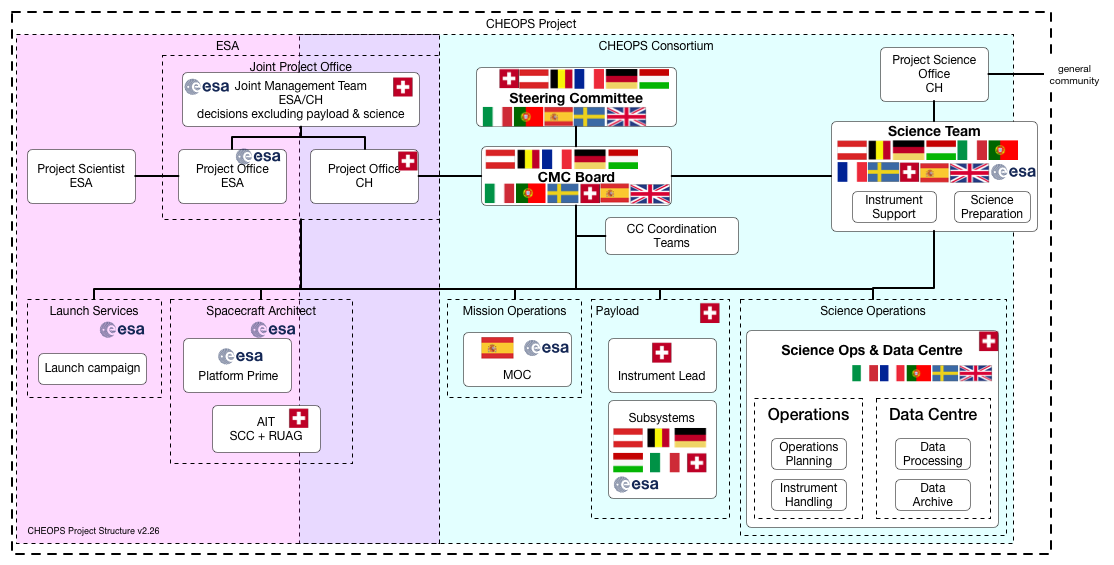Mission organisation
Introduction
The Characterising ExOPlanet Satellite (CHEOPS) mission is a joint ESA-Switzerland project, with important contributions from a number of Member States, cooperating within a dedicated CHEOPS Mission Consortium (CMC). On 19 October 2012, CHEOPS was selected by the Science Programme Committee for study as the first Small class mission in Cosmic Vision 2015-2025.The mission has been adopted by the Science Programme Committee on 19 February 2014, with launch planned for 2018.
The project management approach applied to the CHEOPS mission is based on the agreements among the parties described in the Multilateral Agreement and follows on the fundamental organisational principles defined in the Science Management Plan.
Mission Objective
“CHEOPS will be the first mission dedicated to search for exoplanetary transits on bright stars already known to host planets. The instrument will be able to point towards almost any locations on the sky and perform ultrahigh precision photometry. It will provide the unique capability of determining accurate radii for a subset of those planets in the super-Earth to Neptune mass range, for which the mass has already been estimated from ground-based spectroscopic surveys. It will also provide accurate radii for new planets discovered by the next generation of ground-based transits surveys (Neptune-size and smaller). By unveiling transiting exoplanets with high potential for in-depth characterisation, CHEOPS will also provide golden targets for future instruments suited to the spectroscopic characterisation of exoplanetary atmospheres”.
Organizational Structure
The CHEOPS mission is a joint mission between ESA and Switzerland. Switzerland leads the consortium of countries participating in the mission, h.f. the CHEOPS Mission Consortium (CMC), through the principal investigator (PI) Prof. Willy Benz at the University of Bern.
The following sketch shows the organization of the mission: ESA and Switzerland together form the Joint management team that manages the overall mission. Furthermore, the mission is divided into mission elements under ESA responsibility (magenta background) and consortium responsibility (cyan background).
ESA is responsible for:
- Mission architect
- Rocket launch of the satellite
- Procurement of the satellite platform
- System level assembly integration and testing (AIT)
The consortium is responsible for:
- Ground segment including mission operations center (MOC) and science operations center (SOC) and science data center
- The instrument assembly and its calibration
- Support to system level AIT
- Science preparation and exploitation
The consortium side is managed by the CHEOPS Mission Consortium Board (CMC board) where all participating countries are represented. Decisions related to funding are decided by the representatives of all funding agencies through the steering committee. Day-to-day working level activities in the consortium are organized through Coordination teams. Currently there are two coordination team: one for the instrument (ICT), and one for the ground segment (GCT). The Science Team is formed from members of all consortium states and is responsible for Science preparation and exploitation.
 CHEOPS Mission Organization. Magenta background indicates ESA responsibility and cyan background consortium responsibility.
CHEOPS Mission Organization. Magenta background indicates ESA responsibility and cyan background consortium responsibility.
CHEOPS Mission Consortium (CMC)
The CMC is formed of institutes in 11 European countries. Each country is present in the CMC board with two members plus the mission PI. Some countries have not yet nominated both board delegates. The current composition of the CMC board is shown in the following table:
Board Members:
| Name | Country | Institute |
|---|---|---|
| Christiane Helling | A | Institut für Weltraumforschung, Graz |
| Wolfgang Baumjohann | A | Institut für Weltraumforschung, Graz |
| Michaël Gillon | B | University of Liège |
| Valérie Van Grootel | B | Université de Liège |
| Christopher Broeg | CH | Universität Bern |
| Stéphane Udry | CH | Observatoire astronomique de l’Université de Genève |
| Yann Alibert | CH | Universität Bern |
| Anders Erikson | D | DLR Institute of Planetary Research |
| Heike Rauer | D | DLR Institute of Planetary Research |
| Enric Pallé | E | The Instituto de Astrofísica de Canarias |
| Ignasi Ribas | E | Institute for Space Sciences |
| Alain Lecavelier des Etangs | F | Institut d'astrophysique de Paris |
| Magali Deleuil | F | Laboratoire d'astrophysique de Marseille |
| Laszlo Kiss | H | Konkoly Observatory |
| Tamas Bárczy | H | Admatis |
| Isabella Pagano | I | Osservatorio Astrofisico di Catania - INAF |
| Roberto Ragazzoni | I | Osservatorio Astronomico di Padova - INAF |
| Nuno Santos | P | Centro de Astrofisica da Universidade do Porto |
| Sérgio Sousa | P | Centro de Astrofisica da Universidade do Porto |
| Göran Olofsson | S | Stockholm University, Stockholm |
| Melvyn Davies | S | Lund University |
| Don Pollacco | UK | University of Warwick |
| Nicholas Walton | UK | University of Cambridge |
Each country inside the CMC is responsible for one or several parts of the mission, either for the ground segment, the payload, or both. The rough distribution of these contributions is indicated with Flags in the organogram above.